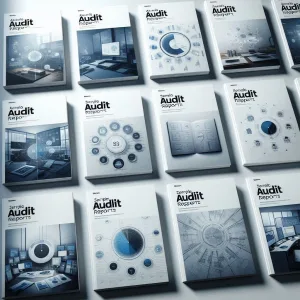In the realm of internal audit, ISO frameworks play a pivotal role in enhancing risk management strategies. Understanding these frameworks, perhaps through an ISO course, is essential for risk and internal audit professionals who aim to align their practices with internationally recognized standards.
- Definition of ISO Frameworks and Their Purpose: ISO frameworks refer to a set of guidelines and standards developed by the International Organization for Standardization (ISO) to ensure quality, safety, efficiency, and interoperability across various sectors. These frameworks provide a structured approach for organizations to establish, implement, maintain, and continually improve their management systems, including those related to quality, environmental management, and information security. By adhering to ISO standards, organizations can enhance their operational effectiveness and ensure compliance with regulatory requirements.
- Importance of Risk Management in Internal Audit: Risk management is a critical component of internal audit as it helps organizations identify, assess, and mitigate potential risks that could hinder their objectives. Effective risk management ensures that internal audits are not only compliant with standards but also strategically aligned with the organization’s goals. It enables auditors to focus on areas of highest risk, thereby optimizing resource allocation and enhancing the overall effectiveness of the audit process. The integration of risk management within internal audit functions fosters a proactive approach, allowing organizations to anticipate challenges and respond effectively.
- Integration of ISO Standards in Risk Management: The integration of ISO standards into risk management strategies provides a robust framework for organizations to manage risks systematically. For instance, ISO 31000 offers principles and guidelines for risk management that can be seamlessly incorporated into internal audit processes. By aligning internal audit practices with ISO standards, organizations can ensure a comprehensive approach to risk assessment and management, leading to improved decision-making and enhanced organizational resilience. This integration not only strengthens the internal audit function but also contributes to the overall governance and accountability within the organization.
ISO frameworks are essential tools for internal audit professionals, providing a structured approach to risk management that enhances organizational effectiveness and compliance. Understanding and integrating these frameworks into audit practices is crucial for fostering a culture of continuous improvement and risk awareness within organizations.
Understanding Key ISO Standards Relevant to Internal Audit
In the realm of internal audit, the integration of ISO frameworks plays a pivotal role in enhancing risk management strategies. Several ISO standards provide essential guidelines and principles that can significantly improve the effectiveness of internal audit processes. Below are key ISO standards that are particularly relevant:
- ISO 9001: Quality Management Systems: This standard focuses on ensuring that organizations consistently meet customer and regulatory requirements while enhancing customer satisfaction. It establishes a framework for a quality management system (QMS) that can help internal auditors assess the effectiveness of processes and identify areas for improvement. By adhering to ISO 9001, organizations can create a robust foundation for risk management by ensuring quality is embedded in all operations [1].
- ISO 31000: Risk Management Principles and Guidelines: ISO 31000 provides a comprehensive framework for risk management applicable to any organization regardless of size or sector. It outlines principles and guidelines for creating a risk management framework and process, which are crucial for internal auditors. This standard emphasizes the importance of integrating risk management into the organization’s governance structure, thereby enabling auditors to evaluate how well risks are identified, assessed, and managed.
- ISO 27001: Information Security Management Systems: This standard is vital for organizations looking to protect their information assets. ISO 27001 outlines the requirements for establishing, implementing, maintaining, and continually improving an information security management system (ISMS). Internal auditors can leverage this standard to assess the effectiveness of information security controls and ensure that risks related to information security are adequately managed [3].
- ISO 14001: Environmental Management Systems: ISO 14001 provides a framework for organizations to manage their environmental responsibilities. It emphasizes the importance of internal audits in monitoring and improving environmental performance. By integrating this standard into internal audit processes, organizations can ensure compliance with environmental regulations and identify risks associated with environmental impacts, thus enhancing their overall risk management strategy [4].
Importance of These Standards in Establishing a Risk Management Framework
The integration of these ISO standards into internal audit processes is crucial for several reasons:
- Holistic Risk Management: By adopting a combination of these standards, organizations can develop a comprehensive risk management framework that addresses quality, information security, and environmental concerns, leading to a more resilient organization.
- Continuous Improvement: ISO standards promote a culture of continuous improvement, which is essential for effective risk management. Internal audits based on these standards can help identify weaknesses and areas for enhancement, fostering an environment of proactive risk management.
- Stakeholder Assurance: Compliance with recognized ISO standards provides assurance to stakeholders, including management and regulatory bodies, that the organization is effectively managing risks and adhering to best practices.
Understanding and implementing these key ISO standards can significantly enhance the internal audit function, enabling organizations to better manage risks and improve overall performance. By leveraging the frameworks provided by ISO 9001, ISO 31000, ISO 27001, and ISO 14001, internal audit professionals can ensure that their risk management strategies are robust, comprehensive, and aligned with international best practices.
The Integration of ISO Frameworks into Risk Management Strategies
Integrating ISO frameworks into risk management strategies is essential for internal auditors aiming to enhance their organization’s resilience and decision-making processes. Here are key points to consider when exploring this integration:
Steps for Integrating ISO Standards into Existing Risk Management Processes
- Understand the ISO Frameworks: Familiarize yourself with relevant ISO standards, such as ISO 31000, which provides guidelines for risk management applicable to organizations of any size. This standard emphasizes the importance of integrating risk management into all aspects of an organization’s activities and decision-making processes.
- Assess Current Processes: Conduct a thorough assessment of existing risk management processes to identify gaps and areas for improvement. This involves evaluating how risks are currently identified, assessed, and managed within the organization.
- Align with Organizational Objectives: Ensure that the integration of ISO standards aligns with the organization’s strategic objectives. This alignment helps in making informed decisions that consider both risks and opportunities, ultimately leading to better organizational performance [1].
- Develop a Structured Approach: Adopt a systematic and structured approach to risk management that incorporates ISO principles. This includes defining roles and responsibilities, establishing risk assessment methodologies, and creating a risk register that reflects the organization’s risk landscape [3].
- Training and Awareness: Implement training programs for staff to enhance their understanding of ISO standards and their application in risk management. This can include workshops and seminars that focus on practical tools and techniques for identifying and managing risks.
Common Challenges Faced During Integration and Strategies to Overcome Them
Resistance to Change: One of the most common challenges is resistance from employees who may be accustomed to existing processes. To overcome this, it is crucial to communicate the benefits of integrating ISO frameworks clearly and involve staff in the transition process to foster buy-in.
Lack of Resources: Organizations may face resource constraints, including time and personnel, when integrating ISO standards. To address this, prioritize the integration process by setting realistic timelines and allocating dedicated resources to ensure a smooth transition.
Complexity of Frameworks: The complexity of ISO frameworks can be daunting. Simplifying the integration process by breaking it down into manageable steps and providing clear guidelines can help mitigate this challenge. Additionally, leveraging external expertise or consulting services can provide valuable insights and support during the integration phase [5][7].
Monitoring and Continuous Improvement: After integration, organizations must establish mechanisms for monitoring the effectiveness of the new risk management processes. Regular reviews and updates based on feedback and changing circumstances will ensure that the integration remains relevant and effective.
By effectively integrating ISO frameworks into risk management strategies, internal auditors can enhance their organization’s ability to anticipate challenges and seize opportunities, ultimately leading to improved governance and operational stability.
Benefits of Utilizing ISO Frameworks for Risk Management
Incorporating ISO frameworks into internal audit processes offers numerous advantages that can significantly enhance risk management strategies. Here are some key benefits:
- Improved Consistency and Reliability in Risk Assessment: ISO frameworks, such as ISO 31000, provide structured guidelines that help organizations standardize their risk assessment processes. This consistency ensures that risks are evaluated uniformly across different departments and projects, leading to more reliable outcomes and better-informed decision-making [2][6].
- Enhanced Credibility and Stakeholder Confidence: Adopting recognized ISO standards can bolster an organization’s credibility. Stakeholders, including clients, investors, and regulatory bodies, often view compliance with ISO frameworks as a commitment to quality and risk management excellence. This perception can enhance trust and confidence in the organization’s operations and governance [5][8].
- Facilitation of Continuous Improvement and Adaptation: ISO frameworks emphasize the importance of continual improvement. By integrating these frameworks into internal audit processes, organizations can regularly assess and refine their risk management strategies. This adaptability is crucial in a rapidly changing business environment, allowing organizations to respond effectively to emerging risks and opportunities [9][11].
- Alignment with Global Best Practices and Standards: Utilizing ISO frameworks ensures that an organization’s risk management practices are aligned with international best practices. This alignment not only enhances the effectiveness of risk management strategies but also facilitates compliance with regulatory requirements, thereby reducing the risk of legal and financial penalties [3][12].
The integration of ISO frameworks into internal audit risk management not only strengthens the overall risk management process but also fosters a culture of quality and continuous improvement within the organization. By leveraging these frameworks, risk and internal audit professionals can enhance their effectiveness and contribute to the organization’s long-term success.
Practical Steps for Implementing ISO Frameworks in Internal Audit
Integrating ISO frameworks into risk management strategies is essential for internal audit professionals aiming to enhance their organization’s governance and compliance. Here are actionable steps to effectively implement these frameworks:
- Conducting a Gap Analysis: Begin by assessing your current internal audit practices against relevant ISO standards, such as ISO 31000 for risk management. This analysis will help identify discrepancies between existing processes and the requirements set forth by the ISO framework. By pinpointing areas for improvement, organizations can prioritize actions that align with best practices in risk management [10][12].
- Developing a Roadmap for Implementation: Once the gap analysis is complete, create a detailed roadmap that outlines the steps necessary for integrating ISO frameworks into your internal audit processes. This roadmap should include timelines, resource allocation, and specific milestones to track progress. It is crucial to ensure that the roadmap aligns with the organization’s overall strategic objectives and risk management goals [15].
- Training and Capacity Building for Internal Audit Teams: To successfully implement ISO frameworks, it is vital to invest in training and capacity building for internal audit teams. This includes providing education on ISO standards, risk assessment techniques, and the specific methodologies that will be employed. By enhancing the skills and knowledge of the audit team, organizations can foster a culture of compliance and continuous improvement [4].
- Monitoring and Evaluating the Effectiveness of Implemented Frameworks: After the ISO frameworks have been integrated, establish a system for monitoring and evaluating their effectiveness. This involves setting key performance indicators (KPIs) to measure the impact of the frameworks on risk management processes. Regular reviews and audits should be conducted to ensure that the frameworks remain relevant and effective in addressing emerging risks and compliance requirements [10][11].
By following these practical steps, internal audit professionals can effectively harness ISO frameworks to strengthen their risk management strategies, ultimately leading to improved organizational performance and compliance.
Future Trends: The Role of ISO Frameworks in Evolving Risk Management Practices
As the landscape of risk management continues to evolve, the integration of ISO frameworks into internal audit practices is becoming increasingly significant. This section explores the emerging trends and future implications of ISO standards in the realm of internal audit, particularly focusing on technology, sustainability, and corporate governance.
The Impact of Technology on Risk Management and ISO Frameworks
- Digital Transformation: The advent of digital technologies and Industry 4.0 is reshaping risk management practices. Organizations are leveraging advanced analytics tools to streamline audit processes, which not only enhances efficiency but also provides deeper insights into emerging risks and opportunities [5].
- Cybersecurity Integration: With the rise of cyber threats, internal auditors are expected to collaborate with management to develop robust cybersecurity strategies. This includes integrating cybersecurity risks into the audit plan and evaluating programs against established frameworks like ISO 27001, which is crucial for maintaining information security [12].
- Data-Driven Decision Making: The use of data analytics in risk assessment is becoming more prevalent. ISO standards are being updated to incorporate advanced risk management frameworks that help organizations identify, assess, and mitigate risks more effectively in a data-driven environment [15].
The Role of ISO Standards in Sustainability and Corporate Governance
- Sustainability Focus: There is a growing demand for auditors who specialize in ISO standards that address sustainability, such as ISO 26000 for social responsibility and ISO 14000 for environmental management. This trend reflects the increasing global emphasis on sustainable operations and the need for organizations to comply with stricter guidelines [11].
- Corporate Governance: ISO frameworks are also playing a pivotal role in enhancing corporate governance. By providing structured approaches to risk management, these standards help organizations align their risk management strategies with governance practices, ensuring accountability and transparency.
Predictions for Future Developments in Internal Audit Practices
- Increased Emphasis on Risk Management: As organizations face heightened uncertainty from various sources, including cybersecurity threats and global supply chain disruptions, the role of internal audit is expected to expand. Auditors will increasingly focus on forward-looking assessments of emerging risks, utilizing key risk indicators to highlight potential control failures [15].
- Integration of ISO Frameworks: The future of internal audit will likely see a deeper integration of ISO frameworks into risk management strategies. This will not only enhance the effectiveness of audits but also ensure that organizations are better equipped to navigate the complexities of modern risk landscapes [1][10].
- Adaptation to Regulatory Changes: With new regulations continuously emerging, internal audit practices will need to adapt accordingly. ISO standards will serve as a foundation for compliance, helping organizations to meet regulatory requirements while maintaining robust risk management practices.
The integration of ISO frameworks into internal audit practices is set to play a crucial role in shaping the future of risk management. By embracing technological advancements, focusing on sustainability, and adapting to regulatory changes, internal auditors can enhance their effectiveness and contribute to the overall resilience of their organizations.
Conclusion
In the realm of internal audit, the integration of ISO frameworks into risk management strategies is not just beneficial; it is essential for fostering a robust and resilient organizational environment. Here are the key takeaways:
- Importance of ISO Frameworks: ISO standards provide a structured approach to risk management, ensuring that organizations can identify, assess, and mitigate risks effectively. By adhering to these internationally recognized frameworks, internal audit professionals can enhance their credibility and the overall effectiveness of their audit processes. The systematic nature of ISO frameworks helps in establishing clear guidelines and best practices, which are crucial for maintaining compliance and achieving organizational objectives.
- Call to Action: Internal audit professionals are encouraged to actively consider the integration of ISO frameworks into their risk management strategies. This integration not only aligns audit practices with global standards but also promotes a culture of accountability and transparency within organizations. By embracing ISO standards, auditors can better equip themselves to address emerging risks and adapt to the ever-evolving business landscape.
- Value of Continuous Improvement: The journey towards effective risk management is ongoing. Continuous improvement is a fundamental principle of ISO frameworks, and it should be a core focus for internal audit professionals. By regularly reviewing and refining audit processes, organizations can ensure they remain agile and responsive to new challenges. This commitment to improvement not only enhances the quality of audits but also contributes to the overall resilience and sustainability of the organization.
In conclusion, the integration of ISO frameworks into risk management is a strategic move that internal audit professionals should prioritize. By doing so, they can significantly enhance their effectiveness, drive organizational success, and foster a culture of continuous improvement.
Find out more about Shaun Stoltz https://www.shaunstoltz.com/about/
This post was written by an AI and reviewed/edited by a human.



